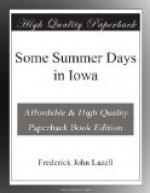Does he not still live among us? Does he not question
us, teach us? Yellow loose-strifes and rattle-box
are in the swamp, and a patch of swamp milkweed with
brilliant fritillaries sipping nectar from its purple
blossoms. White wands of meadow-sweet, clusters
of sensitive fern, a big shrub of pussy willow with
cool green leaves as grateful now as the white and
gold blossoms were in April; white trunks and fluttering
leaves of small aspens where the grosbeak has just
finished nesting; bushy willows and withes of young
poplar; nodding wool-grasses and various headed sedges;
all these are between the roadside and the fence.
There the elder puts out blossoms of spicy snow big
as dinner-plates and the Maryland yellow-throat who
has four babies in the bulky nest at the foot of the
black-berry bush sits and sings his “witchity,
witchity, witchity.” The lark sparrow has
her nest at the foot of a thistle and her mate has
perched so often on a small elm near-by that he has
worn several of the leaves from a topmost twig.
In the late afternoons and evenings he sits there and
vies with the indigo bunting who sits on the bare branches
at the top of a tall red oak, throwing back his little
head and pouring out sweet rills of melody. Near
him is the dickcissel, incessantly singing from the
twig of a crab-apple; these three make a tireless trio,
singing each hour of the day. The bunting’s
nest is in a low elm bush close to the fence where
a wee brown bird sits listening to the strains of the
bright little bird above and the little dickcissels
have just hatched out in the nest at the base of a
tussock not very far away.
Now the evening primrose at the side of the road has
folded all its yellow petals, marking the near approach
of noon. Growing near it on this rise of the
road are lavender-flowered bergamot, blue and gold
spiderwort, milkweeds in a purple glory, black-eyed
Susans basking in the sun, cone-flowers with brown
disks and purple petals, like gypsy maidens with gaudy
summer shawls. Closer to the fence are lemon-yellow
coreopsis with quaint, three-cleft leaves; thimble
weeds with fruit columns half a finger’s length;
orange-flowered milkweed, like the color of an oriole’s
back, made doubly gay by brilliant butterflies and
beetles. On the sandy bank which makes the background
for this scene of splendor, the New Jersey tea, known
better as the red-root, lifts its feathery white plumes
above restful, gray-green leaves. Just at the
fence the prairie willow has a beauty all its own,
with a wealth of leaves glossy dark green above and
woolly white below.
There’s a whine as if someone had suddenly struck
a dog and a brownish bird runs crouching through the
grass while little gingery-brown bodies scatter quickly
for their hiding places. It was near here that
the quail had her nest in June and these are her babies.
I reach down and get one, a little bit of a chick
scarcely bigger than the end of my thumb. The
mother circles around, quite near, with alarm and
distress until I back away and watch. Then she
comes forward, softly clucking, and soon gathers her
chickens under her wings.




